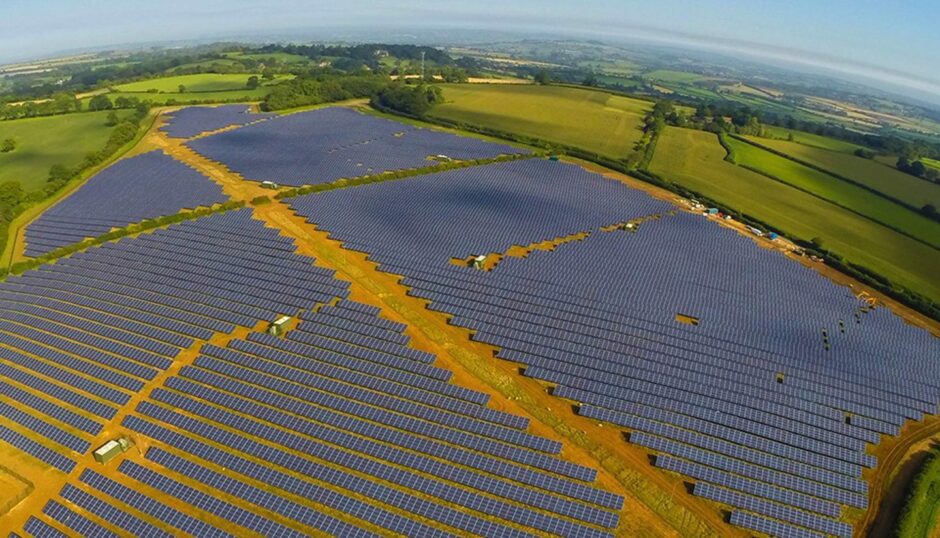
Solar farms, when implemented in line with current planning requirements, are not unpopular, do not harm biodiversity, and do not use land to the detriment of food production. They also provide business rates for local governments, rural jobs, and a vital source of income for British farmers. So why is the government considering policy that would severely restrict solar farm development in England?
According to the Guardian, Ministers are planning to ban solar farms from most of England’s farmland. The new Secretary of State for Defra, Ranil Jayawardena, is reportedly seeking to expand the definition of “best and most versatile” land (BMV), which is earmarked for farming, to include the middling-to-low category 3b. Land is graded from 1 to 5, and currently BMV includes grades 1 to 3a. Currently, most solar farms are built on and planned for 3b land, so extending BMV to grade 3b would eliminate most new developments of the renewable energy source, and ban solar from about 41% of the land area of England, or about 58% of agricultural land.
The plans are justified on the grounds that solar farms are a threat to the UK’s food security, a claim that Liz Truss made several times during her Conservative leadership campaign. The Climate Change Committee identify within their scenarios for achieving Net Zero that total Solar generation will need to increase from 10 TWh in 2019 to 60 TWh in 2035 and 85 TWh in 2050.
On average, 3 GW per year will need to be installed to reach this level of solar generation, which has been also reflected in government policy. As Defra recognise that the single largest threat to the UK’s food security is climate change, solar is perhaps not such a threat to our food security after all.
At the REA, we are deeply concerned by speculation that the government will tighten restrictions on solar farm development. While we undoubtedly need to ensure any site is suitable for renewable development, the contrast with fracking and fossil developments sends a damaging signal. These common arguments presented in opposition to solar farm developments can be combatted simply, alongside evidence that this anti-solar sentiment is not representative of the UK population. Recent surveys indicate 90% total support for solar with only 1% total in opposition, making solar the most popular renewable technology.
Solar power is an abundant resource providing low-cost renewable generation, and solar farms are essential for the UK to reach Net Zero by 2050. Already producing as much as 30% of UK electricity at certain points in the year, over a million homes, businesses and landowners in the UK have installed solar panels over the past decade, providing electricity directly to residential and commercial premises, as well as to the grid.
Furthermore, reaching Net Zero solar targets does not require significant land use. Carbon Brief’s Simon Evans has helpfully shown that Solar farms currently use 180km2 of land in the UK, compared to 500km2 for airports, 1300km2 for golf courses, or 71,000km2 of land used for pasture. To reach the solar deployment required to meet Net Zero by 2050, solar land use will stand a little over golf courses at 1500km2.
In round numbers:
180km2 = UK's current solar farms
500km2 = UK airports
700km2 = quarries
1,300km2 = golf courses
1,500km2 = enough solar for net-zero by 2050 https://t.co/F08NRJ4XYy— Simon Evans (@DrSimEvans) January 31, 2022
Most importantly, solar does not take away agricultural land that could be used for food production. The independent National Food Strategy Review concludes that solar farms do not present a risk to the UK’s food security if solar farms are built in line with current planning guidance. The solar industry regularly works with farmers to reduce their energy costs and improve the sustainability of food production. Solar farm developers actively encourage multipurpose land use, through continued agricultural activity such as livestock grazing between rows or agri-environmental measures that support biodiversity. Solar can also be used on unproductive marginal land providing essential additional revenue to farmers and landowners as part of sustainable farming practices.
The REA stresses that the solar industry aims to work in conjunction with, not against, agricultural use of land, commonly by either building on marginal land or ensuring multi-land use applications. In doing so, it aims to provide additional revenue to farmers – supplementing, not stopping, more traditional livestock and other farming activities.
In the midst of an energy crisis, we encourage the government to recognise their own solar deployment targets, helping developers to deliver food and energy security through the delivery of cheap, renewable solar energy.
 © Supplied by REA
© Supplied by REA